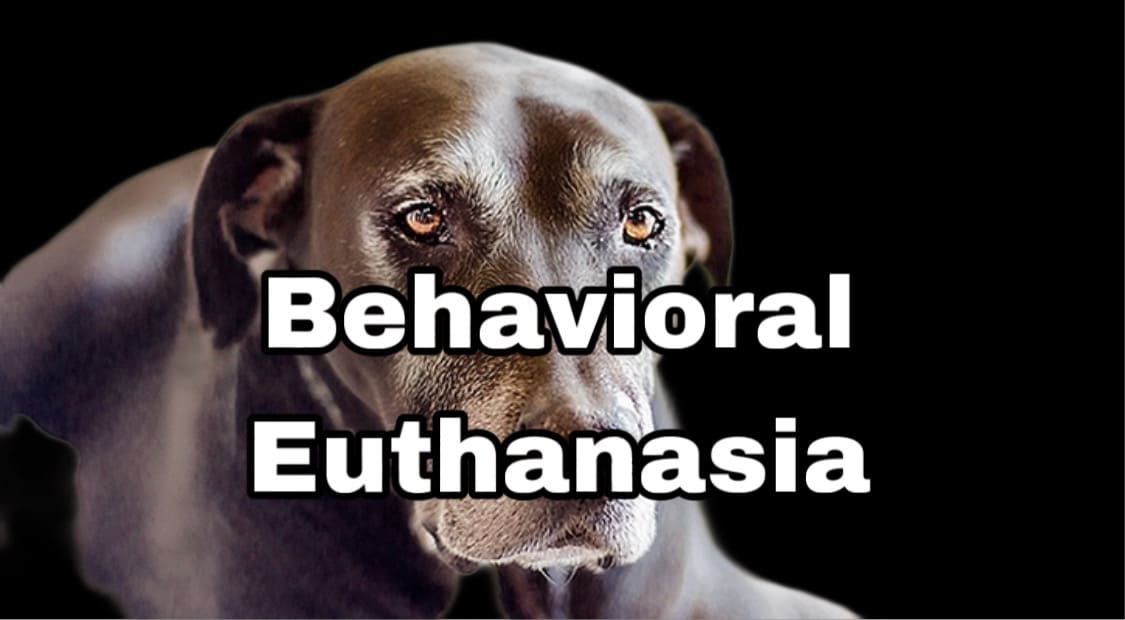
Behavioral euthanasia, a term that carries an immense emotional weight and ethical complexity, refers to the decision to humanely end the life of a pet whose behavioral issues pose a significant risk to the safety and well-being of the pet itself, other animals, and humans. This decision is often considered in cases where severe aggression, profound anxiety disorders, or other extreme behavioral conditions cannot be effectively managed through training, behavior modification, or medical intervention. The essence of this choice stems from a deep commitment to the welfare of the pet and the safety of all beings involved, acknowledging a situation where the pet’s quality of life is irreversibly compromised, and the risks of their behavior are unmanageable.
The gravity of opting for behavioral euthanasia cannot be overstated. It plunges pet guardians into an ocean of moral deliberation, emotional turmoil, and profound grief. The bond between humans and their pets is profound, marked by unconditional love, companionship, and shared experiences. To even consider euthanasia underlines a crisis point where a pet guardian must weigh the inherent value of their beloved companion’s life against the potential harm they may cause, and the suffering the pet may be experiencing. This decision is invariably heart-wrenching, often accompanied by feelings of guilt, doubt, and sorrow, even when made from a place of love and responsibility. For over 35 years I have specialized in severe behavior dog training in Phoenix.
This article is crafted with the intent to serve as a compassionate guide for pet guardians navigating this tumultuous journey. It aims to provide an in-depth exploration of behavioral euthanasia, shedding light on when it may be considered, the ethical and emotional considerations involved, and the process itself. By offering insights into understanding severe behavioral issues, detailing the exhaustive efforts to manage these behaviors, and discussing the indicators that might lead one to consider euthanasia, this piece seeks to support pet guardians through this challenging time. Furthermore, it acknowledges the spectrum of emotions surrounding the decision, offering guidance on coping with the aftermath and finding support.
Our goal is to offer a source of solace, clarity, and understanding for those facing this heart-wrenching decision, ensuring they do not feel alone. This article is a testament to the strength and compassion of pet guardians, emphasizing that considering behavioral euthanasia is, in itself, an act of profound love and responsibility — a decision made in the best interest of the pet and the safety of others, albeit at a significant emotional cost. Through comprehensive information and empathetic support, we aim to assist pet guardians in making informed, compassionate choices during one of the most challenging moments of their journey with their pets.
Facing the Heartache: A Pet Guardian’s Guide to Behavioral Euthanasia
Understanding the complexity of behavioral problems in dogs is crucial for pet guardians seeking to address these issues compassionately and effectively. Severe behavioral issues can profoundly affect not only the safety and well-being of the pet but also the lives of their families and others who interact with them. This section delves into common severe behavioral problems, their impacts, and the underlying causes, offering a foundation for comprehending the challenges that may lead to considering behavioral euthanasia.
Aggression
Aggression in dogs can manifest in various forms, including aggression towards humans, other animals, and in specific situations such as resource guarding or territorial behavior. This behavior is often characterized by growling, barking, snapping, and biting, posing a significant safety risk. The causes of aggression are multifaceted, including genetic predispositions, lack of socialization, previous traumatic experiences, and medical issues. Aggressive behavior not only endangers the safety of others but also significantly limits the dog’s ability to participate in normal social interactions, affecting their quality of life and placing a heavy emotional and logistical burden on pet guardians. I offer Dog aggression training in Phoenix which is focused on safety and management, and then changing the dogs underlying emotional state that is at the root of aggression.
Severe Anxiety Disorders
Anxiety disorders in dogs can severely impair their quality of life, manifesting as persistent fearfulness, phobias, separation anxiety, or generalized anxiety disorder. These conditions may lead to destructive behaviors, self-injury, and an inability to find comfort in day-to-day activities. Anxiety can stem from genetic predispositions, environmental factors, changes in routine, or past traumas. The impact of severe anxiety disorders extends beyond the affected pet, creating a stressful environment for the entire household and complicating normal routines and interactions.
Unmanageable Compulsive Behaviors
Compulsive behaviors in dogs are repetitive, seemingly purposeless actions that the dog feels compelled to perform, such as excessive licking, tail chasing, or pacing. These behaviors often stem from anxiety, stress, or boredom but can become deeply ingrained habits that are difficult to interrupt. In severe cases, compulsive behaviors can lead to physical harm and significantly interfere with the pet’s normal functioning.
Impact on Safety and Well-Being
Severe behavioral problems can drastically impact the safety and well-being of the pet, their family, and others. Aggressive behaviors pose a direct physical threat, while severe anxiety and compulsive behaviors can lead to a life filled with stress and discomfort for the pet and emotional distress for the pet guardians. Managing these behaviors often requires significant adjustments to the household’s routine, financial investments in training and medical interventions, and constant vigilance to prevent harmful situations.
Causes of Severe Behavioral Issues
The root causes of severe behavioral issues are often complex and multifactorial:
- Genetic Factors: Certain breeds may be predisposed to specific behavioral traits, including aggression or anxiety.
- Environmental Factors: Lack of socialization, poor living conditions, inconsistent or harsh training methods, and lack of mental and physical stimulation can contribute to the development of behavioral problems.
- Trauma-Related: Past abuse, neglect, or traumatic events can have a lasting impact on a dog’s behavior, leading to fear-based aggression or anxiety.
Understanding these behavioral issues’ depth, impact, and causes is essential for addressing them effectively and compassionately. It underscores the importance of early intervention, consistent and positive training methods, and seeking professional help when necessary. For pet guardians facing the difficult decision of behavioral euthanasia, this knowledge provides a context for their journey, highlighting the complexities involved in managing severe behavioral problems and the profound impact these issues can have on the quality of life for all involved.
If you find this section informative and wish to delve further into any specific aspect, please let me know to continue providing detailed insights.
Before considering the grave option of behavioral euthanasia, it is paramount for pet guardians to explore all possible alternatives to address their dog’s severe behavioral issues. This exploration emphasizes the crucial role of professional intervention and outlines various strategies and supports that may alleviate or manage the behaviors effectively. The journey toward finding a resolution should be thorough, encompassing a range of approaches from behavioral assessments to medical evaluations and treatment plans.
Importance of Professional Intervention
Working with a Certifed Dog Behaviorist in Phoenix or Certified Dog Behavior Consultants CBCC-KA or CDBC are trained professionals specializing in addressing behavioral issues in dogs. These experts employ evidence-based, humane methods to assess and modify unwanted behaviors. By working with a CBCC-KA or a CDBC, pet guardians can access personalized advice and strategies tailored to their dog’s specific needs and circumstances. This professional guidance is invaluable for understanding the underlying causes of behavioral problems and implementing effective interventions.
The Role of Veterinary Behaviorists
Veterinary behaviorists are veterinarians who have completed additional training in animal behavior. They are uniquely positioned to offer a comprehensive approach that includes both the medical and behavioral aspects of a dog’s issues. Veterinary behaviorists can diagnose and treat health-related issues that may contribute to behavioral problems, providing a holistic strategy that encompasses both medical and behavioral therapies.
Comprehensive Behavioral Assessments and Personalized Treatment Plans
A thorough behavioral assessment is the foundation for any successful intervention plan. This assessment should consider the dog’s history, environment, specific behaviors, and any previous attempts at treatment. Based on this comprehensive evaluation, a personalized treatment plan can be developed. This plan may include behavior modification techniques, environmental management strategies, and, if necessary, a training regimen to address specific issues.
Medical Evaluations to Rule Out or Treat Underlying Health Issues
Behavioral issues can sometimes be symptoms of underlying health problems. Therefore, a complete medical evaluation by a veterinarian is a critical step in the process. Conditions such as thyroid disorders, neurological problems, or chronic pain can significantly affect a dog’s behavior. Identifying and treating these medical issues can lead to substantial improvements in behavior and well-being.
Behavioral Modification Techniques and Management Strategies
Behavior modification techniques aim to change a dog’s response to certain situations or triggers through positive reinforcement, desensitization, and counterconditioning. These methods require patience and consistency but can effectively reduce or eliminate unwanted behaviors. Management strategies, such as modifying the pet’s environment to prevent exposure to stressors or using barriers to prevent aggressive encounters, are also crucial components of a comprehensive behavioral plan.
The Role of Medications in Managing Behavioral Issues
In some cases, medications may be recommended as part of a broader treatment strategy. These can include anti-anxiety medications, antidepressants, or other pharmaceuticals designed to help manage specific symptoms. Medications can be particularly useful for stabilizing a dog’s mood, reducing anxiety, or minimizing aggressive tendencies, thereby enhancing the effectiveness of behavioral modification efforts.
Exploring all these options underscores a commitment to the well-being and quality of life of the pet, aiming to address behavioral issues comprehensively and compassionately. It’s a testament to the dedication of pet guardians to seek humane and effective solutions, exhausting all possibilities before considering the last resort of behavioral euthanasia. This approach not only offers hope for managing challenging behaviors but also reinforces the bond between pets and their guardians, built on understanding, patience, and care.
Making the decision to proceed with behavioral euthanasia is one of the most profound and challenging decisions a pet guardian can face. It involves deep ethical considerations, a thorough assessment of the pet’s quality of life, understanding the safety risks, and considering the legal and societal implications of such a decision. Importantly, it also requires acknowledging the significant impact on the pet guardian’s mental and emotional well-being. This section explores these aspects to provide a comprehensive view of the factors involved in making this heart-wrenching decision.
Ethical Considerations and the Welfare of the Pet
The primary ethical consideration in deciding on behavioral euthanasia is the welfare of the pet. The decision must be grounded in a compassionate assessment of whether the pet’s quality of life is irreversibly compromised by its behavioral issues. It raises fundamental questions about the nature of humane treatment, the responsibilities of pet guardianship, and the moral obligations we have to ensure our pets lead lives free from undue suffering, whether physical or psychological.
Assessing Quality of Life
Tools and Criteria for Evaluating the Pet’s Quality of Life
Evaluating a pet’s quality of life involves considering various factors, including their ability to enjoy daily activities, their level of distress or suffering, and their overall health and behavior. Tools such as the HHHHHMM Scale, which assesses Hurt, Hunger, Hydration, Hygiene, Happiness, Mobility, and More (overall perception of life quality), can be instrumental in making this assessment. These criteria help pet guardians objectively consider their pet’s well-being, focusing on the pet’s comfort and enjoyment of life.
The Role of Behavioral Thresholds and Safety Risks in Decision-Making
Behavioral thresholds refer to the point at which a pet’s behavior becomes unmanageable or poses a significant risk to themselves, other animals, and humans. This includes assessing the likelihood and severity of aggressive incidents, the pet’s ability to live without undue stress or anxiety, and the feasibility of safely managing their behavior. When behavioral issues cross these thresholds, despite exhaustive efforts to address them, euthanasia may be considered as a last resort to prevent further suffering and ensure safety.
Legal and Societal Perspectives on Behavioral Euthanasia
Legal considerations surrounding behavioral euthanasia vary by location but generally require that such decisions are made with the guidance of veterinary professionals and under circumstances where the pet’s behavior is deemed unmanageable and poses a serious risk. Societal perspectives on behavioral euthanasia can be complex, with differing views on animal rights, the responsibilities of pet guardianship, and the ethical implications of euthanizing pets for behavioral reasons. Navigating these perspectives requires sensitivity and a commitment to making a decision that prioritizes the welfare of the pet and public safety.
The Role of the Pet Guardian’s Mental and Emotional Well-Being
The decision to euthanize a pet for behavioral reasons can have a profound impact on the pet guardian’s mental and emotional health. Feelings of guilt, grief, and doubt are common, as is the struggle with the stigma that may come from societal judgments. It’s essential for pet guardians to seek support through this process, whether from mental health professionals, support groups, or communities of pet guardians who have faced similar decisions. Acknowledging and addressing the emotional toll of this decision is a critical part of the process, ensuring that pet guardians are supported in their grief and can find a path toward healing.
Making the decision to proceed with behavioral euthanasia involves a complex interplay of ethical, emotional, and practical considerations. It’s a decision that comes at the end of a long journey of seeking solutions and is made from a place of deep love and responsibility towards the pet. This section aims to provide pet guardians with the insights and support needed to navigate this difficult process with compassion, understanding, and respect for the profound bond between them and their pets.
The process of behavioral euthanasia is a solemn and sensitive journey, encompassing not just the decision-making itself but also preparing for the procedure, understanding its execution, and considering the aftercare for the beloved pet. This pathway is paved with deep compassion, careful consideration, and respect for the life of the animal companion involved. Here, we explore the steps involved in the process, aiming to provide pet guardians with a clear, compassionate guide to navigating this profoundly difficult time.
Preparing for the Decision: What to Expect and How to Plan
Understanding the Procedure
Before making the final decision, it’s crucial for pet guardians to fully understand what the euthanasia procedure entails. This understanding includes the method used, the role of the veterinarian, and any preparations that need to be made in advance. Veterinarians are typically very compassionate and patient in explaining the process, ensuring that pet guardians are prepared for what will happen and are given the opportunity to ask questions or express any concerns.
Emotional Preparation
Equally important is the emotional preparation. This might involve discussions with family members, close friends, or a support network who can provide comfort and understanding. Many find it helpful to plan a special last day or moment with their pet, creating final memories together.
Choosing the Right Time: Signs That It May Be Time to Consider Euthanasia
Determining the right time for euthanasia often involves observing the pet’s behavior and quality of life. Signs that it may be time include a significant escalation in dangerous behaviors, a clear indication that the pet is suffering psychologically, or when the pet’s aggressive or anxious behaviors cannot be safely managed despite exhaustive efforts. The guidance of professionals, such as veterinarians and animal behaviorists, can be invaluable in making this determination.
The Euthanasia Procedure: What It Involves for the Pet and the Pet Guardian
The euthanasia procedure is designed to be as peaceful and painless as possible for the pet. It typically involves administering a sedative followed by an injection of euthanasia solution, which gently leads to the pet’s passing. Pet guardians are often given the choice to be present during the procedure, allowing them to say goodbye in a personal and meaningful way. The veterinarian or clinic staff will guide the pet guardian through the process, providing support and ensuring the pet’s comfort throughout.
Aftercare for the Pet: Options for Cremation, Burial, and Memorials
Aftercare involves decisions about the pet’s remains. Options include cremation, either private or communal, and burial, whether in a pet cemetery or another meaningful location, depending on local regulations. Many pet guardians choose to create a memorial for their pet, such as planting a tree in their honor, creating a photo album or memory box, or holding a small ceremony to celebrate the pet’s life. These acts of remembrance can be therapeutic, helping pet guardians process their grief and honor the bond they shared with their pet.
Navigating the process of behavioral euthanasia from preparation to aftercare is a deeply personal and emotional journey. It’s a path marked by love, respect, and the desire to alleviate suffering, allowing pet guardians to make compassionate decisions in the best interest of their beloved companion. Understanding each step of the process can help pet guardians feel more prepared and supported as they make and carry out this difficult decision.
Navigating the profound grief and loss experienced after the decision of behavioral euthanasia is a deeply personal and challenging journey for pet guardians. The bond between a pet and their guardian is unique and strong, often characterized by unconditional love and companionship. The loss, therefore, can be as intense as the loss of a human family member. Understanding this grieving process, developing coping strategies, leveraging support networks, and knowing when to seek professional help are crucial steps in healing and finding a way forward.
Understanding the Grieving Process for Pet Guardians
Grief is a complex, multifaceted response to loss, encompassing a wide range of emotions such as sadness, anger, guilt, and denial. It’s important for pet guardians to understand that grief is individual and there is no “right” way to feel or grieve. The grieving process includes several stages, though not everyone will experience all stages, nor will they necessarily occur in a linear order. Acknowledging and accepting these feelings as a natural response to loss is a crucial first step in the healing process.
Coping Strategies for Dealing with Guilt, Grief, and Loss
Dealing with the guilt and grief that often accompany the decision of behavioral euthanasia requires compassion towards oneself and the situation. Coping strategies might include:
- Expressing Feelings: Writing in a journal, creating art, or engaging in other forms of self-expression can provide an outlet for grief.
- Celebrating the Pet’s Life: Creating a memorial or tribute can help in focusing on the positive impact the pet had on their guardian’s life.
- Practicing Self-Care: Engaging in physical activity, maintaining a routine, and allowing oneself to rest and grieve are important.
- Setting Aside Guilt: Understanding that the decision was made out of love and compassion, focusing on the pet’s welfare, and recognizing the courage it took to make such a decision can help mitigate feelings of guilt.
The Importance of Support Networks: Family, Friends, and Support Groups
The role of support networks cannot be overstated during this difficult time. Family and friends who understand the significance of the loss can offer much-needed emotional support. Additionally, support groups, either in person or online, connect pet guardians with others who have gone through similar experiences, providing a sense of community and understanding. These groups can be particularly helpful in feeling less isolated in one’s grief.
Seeking Professional Help When Needed
Sometimes, the intensity of grief can be overwhelming, affecting one’s ability to function in daily life. In such cases, seeking professional help from a therapist or counselor specializing in pet loss can be beneficial. These professionals can provide strategies to cope with grief, help work through complex emotions, and guide towards a path of healing. Recognizing when professional help is needed is a sign of strength and an important step in taking care of one’s mental health.
Navigating grief and loss after the euthanasia of a beloved pet is a deeply personal journey that takes time and patience. Understanding that grief is a process, employing coping strategies, leaning on support networks, and seeking professional help when necessary are all important steps in finding a way to heal. It’s essential to remember that grieving the loss of a pet is a reflection of the deep love and bond shared, honoring that bond as part of the journey towards healing.
Navigating the aftermath of a pet’s behavioral euthanasia or coping with severe behavioral issues requires not only emotional support but also access to professional guidance and educational resources. Knowing where to find reliable organizations, support groups, certified professionals, and educational materials can empower pet guardians during these challenging times. This section outlines various resources and support systems available to pet guardians seeking assistance and information on pet loss, behavior management, and prevention of behavioral issues.
Organizations and Support Groups Specializing in Pet Loss
Numerous organizations and support groups offer compassion, understanding, and resources for those grieving the loss of a pet. These include:
- The Association for Pet Loss and Bereavement (APLB): Offers chat rooms, a directory of pet loss counselors, and resources for coping with grief.
- Pet Loss Support Hotlines: Many veterinary schools operate pet loss support hotlines, providing a listening ear and guidance on coping with loss.
- Online Forums and Social Media Groups: Platforms like Facebook and Reddit host communities for pet loss support, where individuals can share their stories and find comfort in the experiences of others.
Professional Resources: Finding Certified Dog Behavior Consultants and Veterinary Behaviorists
For pet guardians seeking help with managing behavioral issues or understanding the options available, consulting with professionals is crucial:
- Certified Dog Behavior Consultants (CDBC): The International Association of Animal Behavior Consultants (IAABC) provides a directory of certified professionals skilled in addressing complex behavioral issues.
- Certified Behavior Consultant Canine (CBCC–KA): The Certification Council For Professional Dog Trainers (CCPDT) and Behavior Consultants is the World’s largest Independent Certifying Organization. These are individuals that are highly qualified and specialize in severe canine behaviors.
- Veterinary Behaviorists: The American College of Veterinary Behaviorists (ACVB) offers a search tool to find board-certified veterinary behaviorists. These professionals can diagnose and treat behavioral problems, often working in conjunction with a pet’s primary veterinarian.
Educational Resources for Understanding and Preventing Severe Behavioral Issues
Educating oneself about pet behavior, training, and health is pivotal in preventing and managing behavioral issues effectively. Some valuable resources include:
- Books and Publications: There are numerous books on dog behavior and training by reputable authors and animal behaviorists. Titles like “Decoding Your Dog” by the American College of Veterinary Behaviorists provide insights into dog behavior and practical advice on addressing common issues.
- Websites and Blogs: Websites such as the ASPCA, the Humane Society, and PetMD offer a wealth of articles on dog behavior, health, and welfare.
- Workshops and Webinars: Organizations like the APDT and the PPG, and various animal welfare groups frequently host workshops and webinars on animal behavior and training techniques.
By leveraging these resources and support systems, pet guardians can find solace in their grief, guidance in managing behavioral challenges, and knowledge to prevent future issues. It’s important to remember that seeking help and information is a sign of strength and commitment to the well-being of both the pet and the pet guardian. Through these avenues, pet guardians can access the support and information needed to navigate the complexities of pet behavior and loss with compassion and understanding.
The journey through understanding, managing, and making critical decisions regarding a pet’s severe behavioral issues culminates in a moment of profound difficulty and bravery. The decision to proceed with behavioral euthanasia, borne out of deep compassion and love, reflects the immense responsibility pet guardians bear for the welfare and safety of their pets, themselves, and others. This conclusion serves not only as a reminder of the weight of such decisions but also as an affirmation of the strength and love that guide them.
Acknowledging the Bravery in Decision-Making
Making the decision for behavioral euthanasia is an act of bravery. It comes from a place of profound compassion, where a pet guardian’s love for their pet and their commitment to preventing suffering takes precedence. This choice, as heart-wrenching as it is, underscores the depth of the bond between pets and their guardians—a bond defined by care, responsibility, and the desire for peace and safety for all beings involved.
Reminding Pet Guardians They Are Not Alone
To those who have faced or may face this decision: you are not alone. The path through managing severe behavioral issues and considering their profound consequences is a journey shared by many. There are communities, professionals, and resources dedicated to supporting pet guardians through these times. The shared experiences within these support networks offer understanding, comfort, and validation to those navigating the complexities of pet behavior and loss.
Encouraging Open Discussions About Behavioral Euthanasia
Open discussions about behavioral euthanasia are vital. They provide much-needed awareness, demystify the process, and offer solace to those who might feel isolated in their experiences. By talking openly about this topic, we can foster a supportive community that acknowledges the challenges of severe behavioral issues and the painful decisions they can necessitate. Such conversations can pave the way for better understanding, compassion, and support for pet guardians, ensuring they have access to the information and emotional backing needed when facing these decisions.
Moving Forward with Compassion and Understanding
As we conclude this exploration into the complex and emotional journey of managing severe behavioral issues in pets, let us carry forward the message of compassion, understanding, and support. Let this guide serve as a resource for those who find themselves on this path, offering insight, comfort, and a reminder of the love that underpins every difficult decision made. By continuing to discuss, learn, and share, we can strengthen the network of support for pet guardians, ensuring that no one has to navigate this challenging journey alone.
In the end, the decisions we make for our pets, borne out of love and compassion, reflect our deepest commitments to their well-being and the safety of those around them. It is a testament to the strength of the human-animal bond and the lengths to which we will go to honor that bond with dignity and respect.
The journey through understanding, addressing, and making decisions regarding a pet’s behavioral issues is complex and multifaceted, requiring a foundation of knowledge, compassion, and support. To further assist pet guardians in navigating these challenges, a compilation of references and further reading is provided. These resources span scientific studies, authoritative books, and insightful articles, offering a comprehensive view of dog behavior, behavioral modification techniques, and the emotional nuances of pet loss. This collection aims to empower pet guardians with information and perspectives that underscore the importance of professional guidance, thorough evaluation, and emotional support throughout the process of managing severe behavioral issues and considering behavioral euthanasia.
Books
- “Decoding Your Dog: The Ultimate Experts Explain Common Dog Behaviors and Reveal How to Prevent or Change Unwanted Ones” by American College of Veterinary Behaviorists – This comprehensive guide offers insights from veterinary behaviorists on understanding and modifying dog behaviors, providing pet guardians with evidence-based strategies for managing common behavioral issues.
- “The Other End of the Leash: Why We Do What We Do Around Dogs” by Patricia B. McConnell – Patricia McConnell explores the fascinating psychological connection between humans and dogs, offering valuable advice on how to communicate more effectively with our canine companions to resolve behavioral issues.
- “Dog Behavior: Modern Science and Our Canine Companions” by James C. Ha and Tracy L. Campion – This book delves into the scientific principles underlying dog behavior, including genetics, learning theory, and social behavior, providing a solid foundation for understanding and addressing behavioral problems.
Scientific Studies and Articles
- “Genetics and the Social Behavior of the Dog” by John Paul Scott and John L. Fuller – This classic study offers foundational insights into how genetics influence dog behavior, including aggression, fear, and socialization patterns. It’s a seminal work for understanding the biological underpinnings of canine behavior.
- “Behavioral Euthanasia of Dogs and Cats: Procedures and Outcomes in U.S. Veterinary Practices” published in the Journal of the American Veterinary Medical Association – This research article provides an overview of the practices and outcomes associated with behavioral euthanasia, offering insights into how these difficult decisions are made in veterinary settings.
- “Management and Personality in Labrador Retriever Dogs” published in Applied Animal Behaviour Science – This study explores the relationship between management practices, personality traits in dogs, and the development of behavioral problems, providing evidence-based insights into preventing and managing issues like aggression and anxiety.
Online Resources
- The American Veterinary Society of Animal Behavior (AVSAB) (avsab.org): AVSAB offers position statements and resources that address common behavioral issues, training techniques, and the importance of early socialization.
- The Association for Pet Loss and Bereavement (APLB) (aplb.org): APLB provides resources for those grieving the loss of a pet, including articles on coping with grief, pet loss support group listings, and advice on euthanasia decisions.
- “Coping with the Loss of a Pet” – This article, available through the Cummings School of Veterinary Medicine at Tufts University (vet.tufts.edu), offers compassionate advice for navigating the emotional process of grieving a pet.
Disclaimer: This guide provides general information and is not intended as a substitute for individualized advice from a veterinary or behavior professional. For any life-and-death decisions regarding a dog’s behavior, seek guidance from qualified experts. If you are experiencing profound grief or distress, consider reaching out to mental health professionals or pet loss support organizations.




